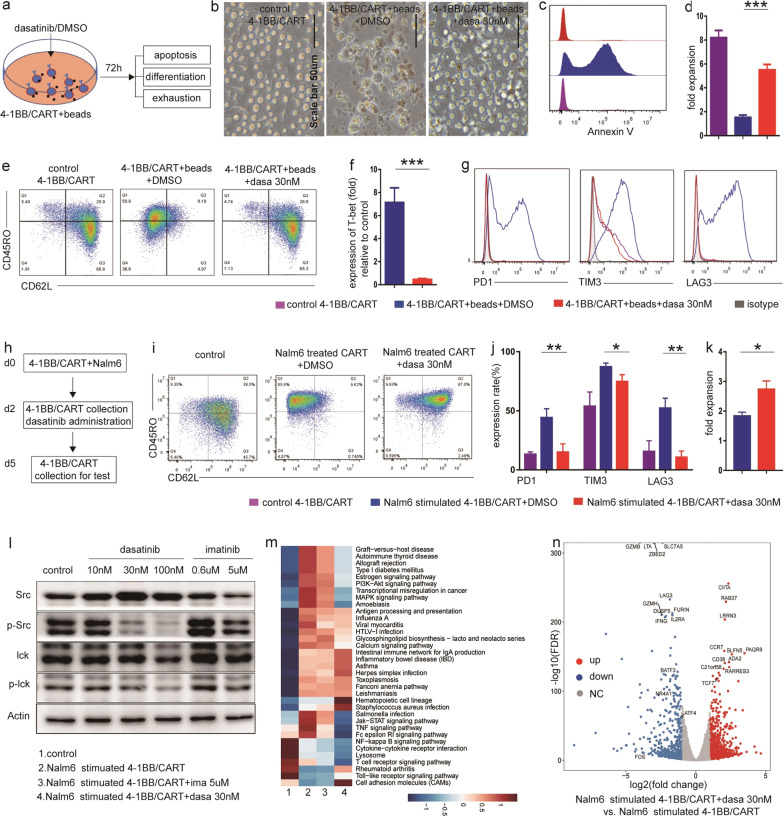Fig. 2.
Dasatinib effectively prevented or reversed the strong activation-induced CART cells differentiation and exhaustion by CD3/CD28 stimulation or antigen exposure. a Schematic diagram showing CD3/CD28 beads and dasatinib or DMSO were simultaneously added into flow-sorted 4-1BB/CART cells, and the apoptosis, differentiation and exhaustion were evaluated 72 h later. b Representative images of CD3/CD28 beads unstimulated, CD3/CD28 beads stimulated and dasatinib-treated CD3/CD28 beads stimulated CART cells. The scale bar represents 50 μm (20 ×). c Representative histograms depicting the expression of Annexin V in different groups. d Absolute numbers of CART cells were determined and by Cedex XS cell count and calculated for cell expansion. e Representative flow cytometry dot plots of CD62L showing the inhibitory effect of dasatinib on 4-1BB CART cell differentiation. f Real-time PCR was performed to identify differentiation related transcription factor T-bet. g Representative histograms depicting the expression of inhibitory receptors. h Schematic diagram showing flow-sorted 4-1BB/CART cells were cocultured with Nalm6 for 48 h, and after eradication of Nalm6, residual CART cells were collected and treated with dasatinib or DMSO for another 72 h. i Representative flow cytometry dot plots for CD45RO and CD62L expression in CART cells. j Representative histograms depicting the expression of PD1, TIM3 and LAG3 in CART cells. k Absolute numbers of CART cells were determined by Cedex XS cell count and calculated for cell expansion in each group. All data mentioned above was given as n = 3 replicates and representative of three donors; *p < 0.05, **p < 0.01, ***p < 0.001; n.s., not significant; mean ± SEM determined by two-tailed unpaired t test. l Western blots were performed to determine the protein levels of Src, p-Src(Tyr416), Lck and p-Lck(Tyr505) in common cultured CART cells treated with DMSO (control), different concentration of dasatinib or imatinib (0.6uM for IC50, 5uM for plasma peak concentration [12]) for 15 min. m 48 h after coculture of CART cells with Nalm6, residual CART cells were collected and treated with DMSO, dasatinib 30 nM or imatinib 5uM for another 72 h, and then cells were collected for transcriptional profiles. Control represents Nalm6 unstimulated CART cells. GO-term enrichment analysis showing the top list of signaling pathways in each group. n Volcano plots showing expression of exhaustion-related regulators (NR4A1, BATF3, ATF4 and FOS), inhibitory receptors (PD1, LAG3), memory-associated transcription factor TCF7 and cell surface marker CCR7 in Nalm6 stimulated CART + dasatinib compared to Nalm6 stimulated CART. Volcano plots were constructed using log2(fold change) and -log10(FDR) values for all genes. Red and blue dots represent genes with more than a twofold change (up or down) in expression and FDR < 0.01

